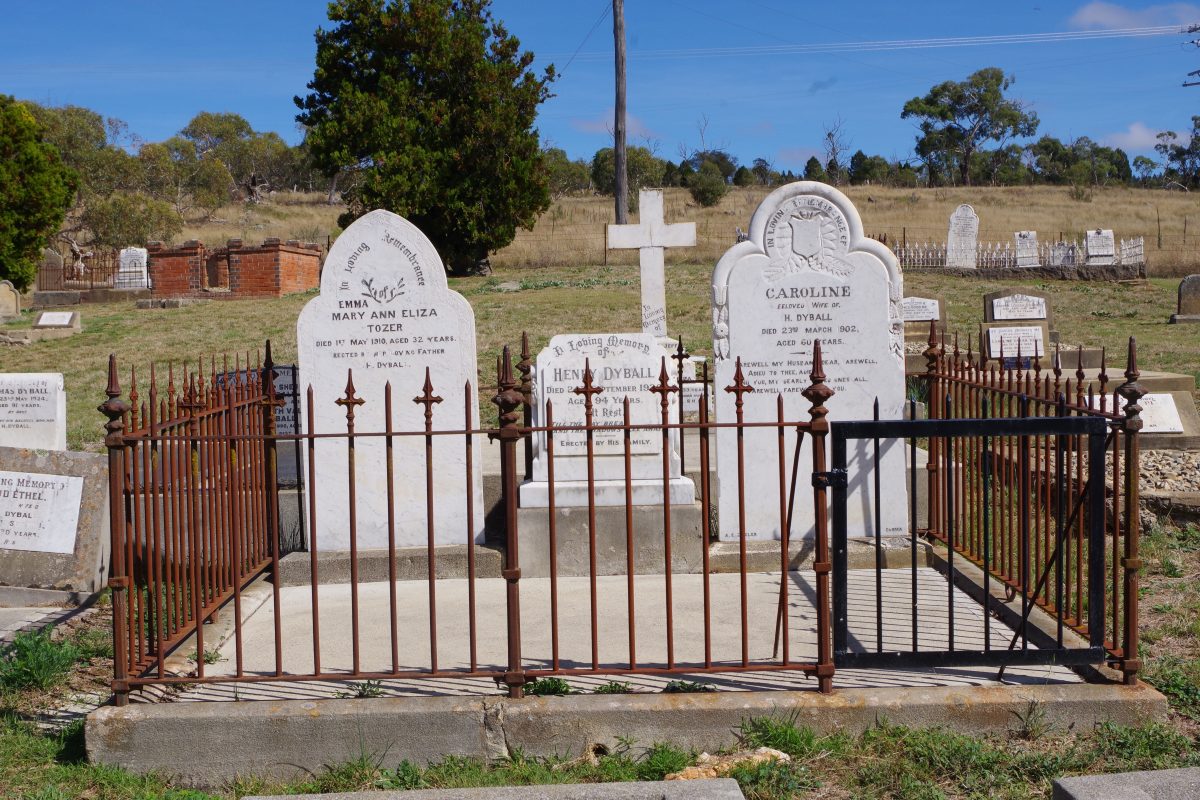
Restoration work on Monaro’s oldest church, Christ Church, has been completed. Photo: Gail Eastaway.
The Monaro’s oldest church, Christ Church on Myalla Road, has been undergoing essential repairs in recent years and a Crown Reserves grant has enabled important external work to be completed.
The church has the distinction of being the oldest on the Monaro and is classified by the National Trust of Australia as a building of interest and architectural merit.
In 2019, a fundraising project was started to fix the church roof and floor.
Public donations raised the necessary money, but work was still needed in the church grounds to control weeds and rabbits.
In February 2022, the Snowy Monaro Regional Council accepted $11,250 from the Crown Reserves Improvement Fund to undertake major rehabilitation and repair work in the cemetery.
Work included the removal of rabbits and rabbit burrows, mowing and weeding, weed spraying, removal of invasive trees, rehabilitation of gravesites, and tree trimming.
This project was a collaborative effort between the council’s biosecurity team, inmates at Cooma Correctional Centre and local business Snowy Mountains Tree Services. Inmates on work release have been engaged to perform maintenance mowing, in addition to rabbit monitoring and weed spraying by the biosecurity team.
Christ Church Cemetery is the final resting place of several Monaro pioneers.

Christ Church Cemetery, Cooma, is the final resting place for many Monaro pioneers. Photo: Gail Eastaway.
Names include: Agnew, Balmain, Barwick, Bastardi, Berkery, Blomfield, Blyton, Bobbine, Bradley, Burke, Collman, Dawson, Devereux, Druitt, Dyball, Ferguson, Flynn, Goodwin, Hain, Hassall, Hawkins, King, Kerwin, Lambie, Litchfield, Lynch, Margochis, Mawson, Mitchell, Montague, Mooney, Norton, O’Rourke, Parker, Reid, Robinson, Rootsey, Ryall, Shanley, Sims, Stewart, Stokes, Sturgeon, Tozer, Wallace, Warne and Williams.
A history of the church, compiled by parishioners Russell Fox and Janet Stalvies in August 2019, states the decision to build the church was taken in 1845.
It was only in 1823, from a site north of Bunyan, that Europeans first sighted this Cooma area.
It lay outside the Limits of Location set by NSW Governor Darling beyond which the acquisition and occupation of land were prohibited.
Those who settled here did so in defiance of the government and became known as squatters.
Victoria did not become a separate state until 1851 so that, in 1845, it was still part of NSW and the Monaro area was regarded as taking in county extending from Michelago well into what became Victoria.
Not surprisingly, it took years for people to settle here in significant numbers and for decades there was no town of Cooma – rather, there existed a “locality”.
A burial ground developed on land along the road that led to Myalla. It is believed that there are several graves here for which there are no records or markers.
Of graves that are recorded, the oldest is that of Johanna O’Rourke, from Tipperary in Ireland, who died aged 21 in 1842.
Another of the early graves is that of Murray Mitchell, the son of the explorer and surveyor Sir Thomas Mitchell, who died aged 18 in 1846.
In 1843, the Reverend Edward Gifford Pryce was appointed by the Church of England as Missionary Chaplain to Monaro and the South Coast. He was the last of the Missionary Chaplains to be sent from England to Australia by the Society for the Propagation of the Gospel, and after months of homelessness, he took up residence at The Grange, a house near the burial ground.
This house remains. At that time, there was no church on the Monaro.
Early in 1845, Bishop William Grant Broughton (the first and only Church of England bishop of Australia) visited this area and while here, after consultation with Pryce, John Lambie (Commissioner for Crown Lands) and Government Surveyor McCabe, decided to build the Christ Church on land adjoining the burial ground.
Bishop Broughton also designed it and on 17 February that year, he laid the foundation stone.
But financial and labouring problems beset the project and the building was not completed until 1850.
The site of the church was absorbed into what became a cemetery.
The cemetery, following Crown Land subdivisions, was broken up into sections along denominational lines – Roman Catholic, Church of England, Wesleyan, Presbyterian, Quaker, Jewish and ”other denominations” in accordance with the practice of the time. Early in the 20th century, the Church of England bought from the Crown that section of the cemetery on which the church stood.
From 1845-1850, the town of Cooma developed quickly and even by the time the construction of Christ Church was completed, it had become apparent that it had been built in the wrong place and was too small.
Services took place at Christ Church from January 1850 until 1872 when a new church, St Paul’s, in town was completed.
Since then, it has been used for Church of England services infrequently – some years not at all.
There have been a few periods when the church was used for services by other Christian groups. It has also been used for special services, most recently in 2011, for descendants of the early settlers of this district buried in the cemetery, and from time to time is visited by groups of people during historic church/building tours.
Following the development of the present cemetery off Mittagang Road in Cooma, the old one was closed to further burials except for a few people who had a close ancestor who was a worshipper at the church during the 22 years that it was the sole Church of England church in the district.
Records show that 243 people are buried in the cemetery, with all but 50 to 60 having died in the 1800s.
With the ravages of time and weather, the church has periodically fallen into disrepair and it underwent renovations in 1926, 1960 and 2001.
The building now stands as a memorial to the early settlers and pioneers of the area, and to Bishop Broughton.







